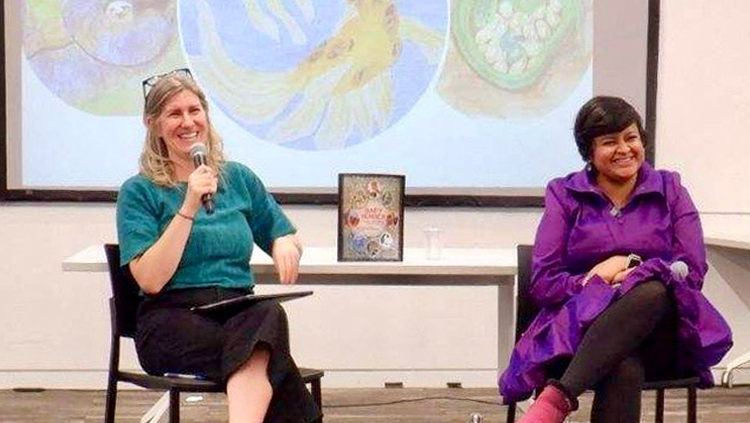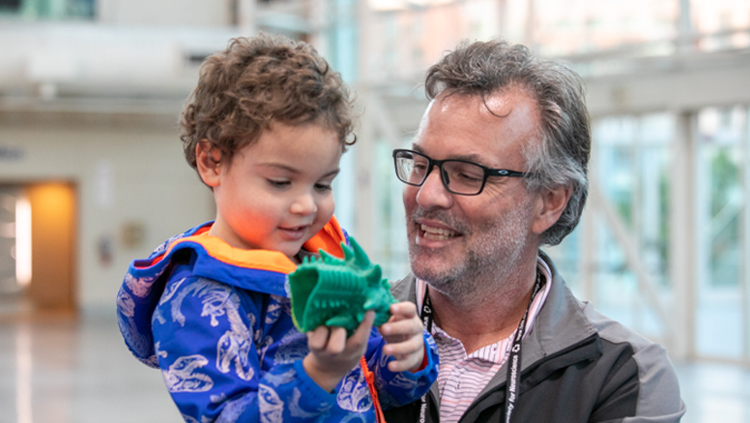
With the help of Carnegie Mellon Nu Rho Psi members, middle school students play partner games and cut out parts of pictures to learn about reflexes and optical illusions.
As an undergraduate at Carnegie Mellon University, Meredith Schmehl co-founded a local chapter of Nu Rho Psi, an outreach-focused neuroscience honor society, and served as the group’s president for two years. In this article she shares best practices for forming and leading a student-led outreach group.
In recent years, many institutions have begun to support student groups focused on educational outreach in the community. Throughout my time as the president of the Nu Rho Psi chapter at Carnegie Mellon, and now as a graduate student at Duke University, people have frequently asked me for advice on forming an outreach group. I recommend taking the following steps to found a successful student organization focused on educational engagement with the public.
Assemble a Team
Perhaps the most important step in establishing an outreach group is to form a leadership team. Find others who are also passionate about sharing science with the community, and invite them to be a part of the process. By assigning a specific role to each team member, you can split up tasks to make the process more manageable.
A typical leadership team might include a president, vice president, secretary, and treasurer, as well as roles such as a webmaster or an event chair depending on the group’s unique needs. In addition, asking a faculty member or student life professional to serve as an advisor can provide a bridge with the university administration, helping to connect the group with the broader mission and resources of the institution.
Identify Your Niche
After forming a team to lead the group, meet as a team to lay the foundation for the organization. What specific role does your group seek to undertake in your campus and local communities? What community needs might your group be able to fill?
Based on the interests of our members and the needs of our community, our Nu Rho Psi chapter adopted three primary goals:
1. Educate the public about neuroscience through outreach.
2. Support the professional development of our members at both the undergraduate and graduate levels.
3. Encourage social interaction between neuroscience students and faculty.
We decided to focus mostly on the first goal in order to share our passion for neuroscience with our community.
Collaborate With Community Partners
You’ve identified your niche — now determine what assistance your group will need to achieve these goals. Organizations outside of your direct department or program can be an invaluable resource in getting started with outreach. Established groups can provide funds, publicity, or other resources that your group may require, and they may even facilitate their own outreach events in which your group can participate.
For example, Carnegie Mellon houses the Leonard Gelfand Center for Service Learning and Outreach, which leads STEM education opportunities for local youth. Our group received support from the Gelfand Center to develop and led a three-hour neuroscience workshop in which children engaged in demonstrations, crafts, and games. Our relationship with the Gelfand Center also led to additional relationships with local schools and the Carnegie Science Center, where we shared fun activities at several STEM education fairs for K–12 children.
In addition, with the help of other established groups at your institution or in the community, your group can collaborate on events or tasks. For example, our Nu Rho Psi chapter held joint events with other student groups such as Psi Chi and Active Minds, as well as groups outside of our institution such as the Nu Rho Psi chapter at the University of Pittsburgh.
Put It in Writing
Once you’ve established a basic structure for your group, consider hosting an initial interest meeting for prospective members from your institution. At this meeting, attendees can work with the leadership team to discuss the mission of the group and draft a written constitution. Many institutions offer a template or sample constitution after which your group can model its own.
Putting your group’s proposed policies in writing will help clarify everyone’s ideas and provide a crucial reference if issues arise in the future. Additionally, creating a constitution will enforce a list of duties for each officer, which will keep the group more organized in carrying out its mission.
Looking Onward
Creating a student-led outreach group is challenging but rewarding. By following the above steps, your group will be ready to start making an impact on the scientifically curious members of your campus and community.
For more advice on engaging with your community and partnering with other initiatives to bring a student-run outreach program to your institution, watch this workshop from Neuroscience 2018.






